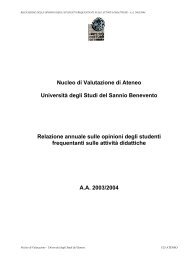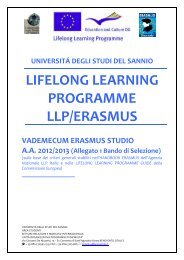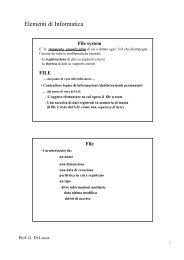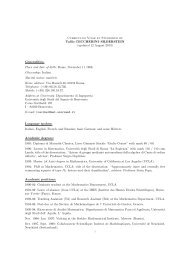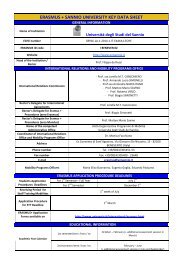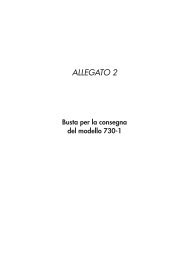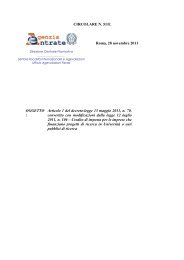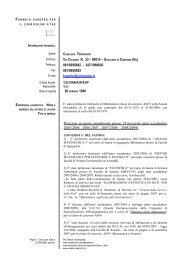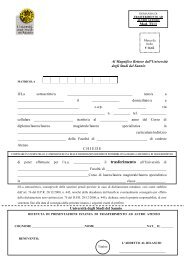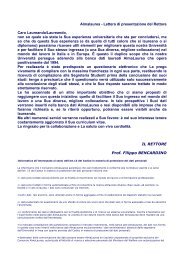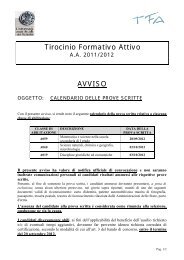Esercizi sui circuiti in regime sinusoidale. - Università del Sannio
Esercizi sui circuiti in regime sinusoidale. - Università del Sannio
Esercizi sui circuiti in regime sinusoidale. - Università del Sannio
Create successful ePaper yourself
Turn your PDF publications into a flip-book with our unique Google optimized e-Paper software.
Esercitazioni di Elettrotecnica – 2002/2003 – A. MaffucciESERCIZIO 8.3Con riferimento al seguente circuito, valutare:a) l'impedenza Z &eq vista ai capi <strong>del</strong> generatore;b) la potenza complessa S & erogata dal generatore;j(t)RCRLj(t)= 10cosR = 2 ΩL = 1 HC = 0.25 F( 2t)A°°°°°°°°°°°°°°°°°°°°°°°°°°°°°°Passando al dom<strong>in</strong>io dei fasori si avrà la rete di impedenze:J = 10 , Z&= − j /( ωC)= −2j,Z&= jωL= 2 j,Z&= R = 2.L'impedenza di <strong>in</strong>gresso vista dal generatore è data da:CLRZ&eq= Z&//[ Z&// Z&+ Z&] = 0.8 + j0.4Ω.RCRLLa potenza complessa erogata da j(t) si valuta facilmente una volta nota : eqZ &1 * 1 * 1 2 (0.8 j0.4)100S& +J ≡ VJJ = Z&eq JJ = Z&eq J == 40 + j20.2 2 22ESERCIZIO 8.4Con riferimento al seguente circuito, valutare:a) la matrice <strong>del</strong>le ammettenze Y & <strong>del</strong> doppio-bipolo visto ai capi dei generatori;b) la potenza complessa S & erogata dai generatori;i ( )i 2 ( t)1 te ( )1 tRL+ +R Ce 2 ( t )e ( t)= 10cos(1000t)V1e ( t)= 20s<strong>in</strong>(1000t)V2R = 1 Ω L = 1mHC = 1 mFRisultato: a) Y &−1−1−111 = 0.5 Ω , Y&= 0.5 j Ω , Y&m22 = 0. 5 − j Ω ;b) S&erer1 = 75W, S&2 = 50W+ j200VAr.
Esercitazioni di Elettrotecnica – 2002/2003 – A. MaffucciESERCITAZIONE N.9: Analisi di reti <strong>in</strong> <strong>regime</strong> s<strong>in</strong>usoidale/2ESERCIZIO 9.1Con riferimento al seguente circuito, valutare la potenza media P assorbita dal resistore R everificare che è possibile sovrapporre le potenze medie.Rj ( t)= cos(100t)Aj 1(t )L Cj 2 ( )j2( t)= s<strong>in</strong>(200t)AR = 1 Ω L = 1mHC = 0.1 mF°°°°°°°°°°°°°°°°°°°°°°°°°°°°°°1Poiché i generatori non sono isofrequenziali, cioè ω 1 ≠ ω2, il circuito non ammette un <strong>regime</strong>s<strong>in</strong>usoidale e qu<strong>in</strong>di non è possibile trasformare la rete <strong>in</strong> una rete di impedenze. Tuttavia, essendola rete l<strong>in</strong>eare, si può applicare la sovrapposizione degli effetti e ricavare la corrente che circola <strong>in</strong>R come i = i ′ + i′, dove i′ si ricava dal circuito ausiliario I e i ′ dal circuito ausiliario II.i′ Ri ′Rj 1(t )L CL Cj 2 ( t )IIICiascuna di queste due reti può essere rappresentata da una rete di impedenze:rete I: J 1 = 1, Z&C′= −100j,Z&L′= 0.1 j,Z&R′= 1.rete II: J 1, Z&′′ = −50j,Z&′′ = 0.2 j,Z&′′ 1.Applicando i partitori di corrente:2 = CLR =Z&L′−3j313.I ′ = J1 = 10 e ⇒ i′( t)= cos(100t+ 3.13) mA.Z&L′+ Z&C′+ Z&R′Z&C′′j312.I ′′ = −J2 = e ⇒ i′′( t)= s<strong>in</strong>(200t+ 3.12) A.Z&′′ + Z&′′ + Z&′′CLRQu<strong>in</strong>di i ( t ) = i′( t)+ i′′( t)= 10 cos(100t+ 3.13) + s<strong>in</strong>(200t+ 3.12) A.−3Nota la corrente si può calcolare la potenza istantanea assorbita da R e qu<strong>in</strong>di la potenza media:TTTT1 1 2 R 2 R 2 2R⎛ 2π2π⎞P = ∫ p(t)dt = ∫ Ri ( t)dt = ∫ i′( t)dt + ∫ i′′( t)dt + ∫ i′( t)i′( t)dt T = maxT TT TT⎜ ,⎟ .00000⎝ ω1ω2⎠I primi due contributi rappresentano le potenze medie dissipate nei <strong>circuiti</strong> I e II, qu<strong>in</strong>di sono:2 R−6i ( t)dt I 0.5 10 W ,T∫′ = ′ = ⋅R T 2 Ri t dt I 0. W2T∫′′ ( ) = ′′ =25 .R T0L'ultimo contributo è nullo perché per ω 1 ≠ ω2si ha: ∫ cos( ω1t+ α)s<strong>in</strong>(ω2t+ β)dt = 0 ∀α,β .In def<strong>in</strong>itiva se ω 1 ≠ ω 2 è possibile sovrapporre le potenze medie: P ≈ 0. 5 W .T00T
Esercitazioni di Elettrotecnica – 2002/2003 – A. MaffucciESERCIZIO 9.2Con riferimento al seguente circuito, valutare la potenza media P assorbita dal resistoreverificare che è possibile sovrapporre le potenze medie.R 2ee(t)+R 1Cj(t)R 2Lj(t)= 14 Ae(t)= 110cos(20t)VR1= 12 ΩR= 2 ΩL = 0.2 H C = 10 mF2Risultato: P = 0.41kW.ESERCIZIO 9.3Valutare l'equivalente di Théven<strong>in</strong> ai capi dei morsetti 1-1'.e(t)+i(t)L+ri(t)°°°°°°°°°°°°°°°°°°°°°°°°°°°°°°Passando alla rete di impedenze si avrà:E = 2ejπ/ 6,CZ&CR= − j,Z&L11′= 4 j,e(t)= 2s<strong>in</strong>(ωt+ π / 6) VR = 2 Ωr = 3 ΩX L = 4 Ω X CZ&R= 2.Per calcolare V 0 basta applicare la LKT alla maglia di s<strong>in</strong>istra <strong>del</strong>la rete:EE = Z & LI+ rI ⇒ I = = 0.368− j0.157Z&L + r.Applicando un partitore di tensione si ha, qu<strong>in</strong>di:Z&R j0.06V0 = rI = 1 .070 + j0.064= 1. 07eV .Z&R + Z&CPer calcolare Z & eq occorre spegnere tutti (e soli) i generatori <strong>in</strong>dipendenti, cioèancora la la LKT alla maglia di s<strong>in</strong>istra <strong>del</strong>la rete:0 = Z&L I + rI ⇒ I = 0= 1ΩE . Applicandoqu<strong>in</strong>di nella rete per il calcolo di Z & eq risulta spento anche il generatore controllato, visto che lasua variabile di controllo è nulla, per cui <strong>in</strong> def<strong>in</strong>itiva:Z&Z&Z& R Ceq = = 0.4(1− 2 j)Ω .Z&+ Z&RC
Esercitazioni di Elettrotecnica – 2002/2003 – A. MaffucciESERCIZIO 9.4Il circuito seguente riproduce lo schema equivalente di un amplificatore a transistor per altafrequenza. Determ<strong>in</strong>are la tensione ai capi <strong>del</strong> resistore di carico(t) v S+R S+v <strong>in</strong>−CR iRo(t) gv <strong>in</strong>LRU+v U−vRRSSU( t)= 10cos( ωt)ω = 108= Rorad / s= 1Ω,= 100 Ω,RL = 1 pH C = 1nFiV= 5 Ωg = 100 Ω−1Risultato: v ( t)= 95.9cos( ωt+ 3.06 kV .ESERCIZIO 9.5U )Con riferimento al seguente circuito valutare la corrente i ( ) nel circuito primario.1 t( )1 ti 2e(t)+R 1L 1L 2Re(t)= 10 2s<strong>in</strong>(1000t)VRL11= 1 Ω= 3 mHR2M = 20 mH= 200 ΩL2= 200 mH2°°°°°°°°°°°°°°°°°°°°°°°°°°°°°°Poiché L1 L2≠ M l'accoppiamento non è perfetto. Posto L 1 = L1′+ L1′, possiamo scegliere L 1′ <strong>in</strong>modo che l'aliquota L ′verifichi le condizioni di accoppiamento perfetto:1221 21 =L′ L = M ⇒ L′′= M / L2 2 mH . A questo punto il circuito equivalente sarà il seguente( )1 tL′1ai 2e(t)R 1L′′+ L 1′R a = 1 = 0. 1 MPer la formula <strong>del</strong> trasporto <strong>del</strong>l'impedenza <strong>in</strong> un trasformatore ideale, il circuito è ancheequivalente al seguente:( ) L′11 te(t)+R 1L 1′i 2a 2 R
Esercitazioni di Elettrotecnica – 2002/2003 – A. MaffucciTrasformato il circuito <strong>in</strong> una rete di impedenze, nella quale si è <strong>in</strong>trodotto il fasorel'impedenza equivalente vista dal generatore è:da cui&Z eq2a R2jωL1′′= R1+ jωL1′+= 2 + 2 j Ω2a R + jωL′′E 5 5 − jπ/ 4I1 = = (1 − j)= e A ⇒ i1( t)= 5s<strong>in</strong>(1000t− π / 4) A .Z&2 2eq2E = 10 V ,ESERCIZIO 9.6Con riferimento al seguente circuito valutare la potenza complessaS &assorbita dal condensatore.j(t)R 1R 2L 1L 2Cj(t)= 10 2 cos(100t)ARL11= R2= 1mH,= 5 ΩL= 4 mHM = 2 mH,C = 12.5 mF2Risultato: S&= − j5VAr .



